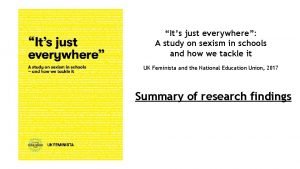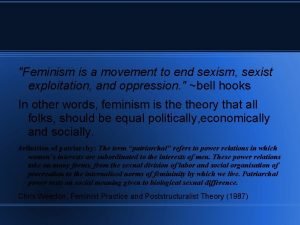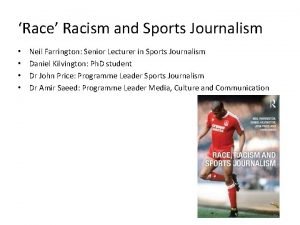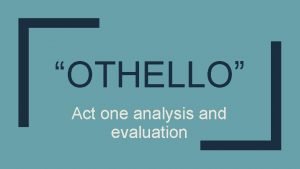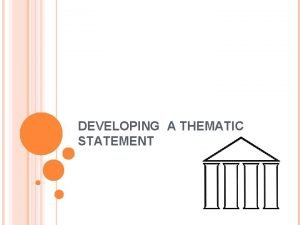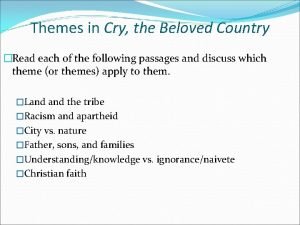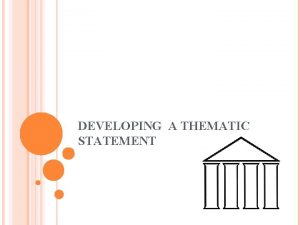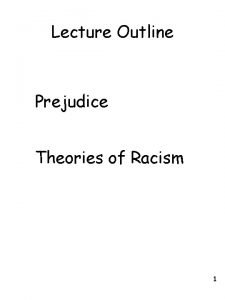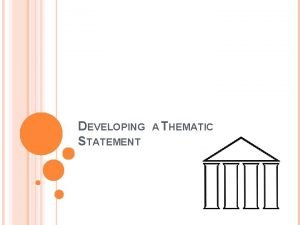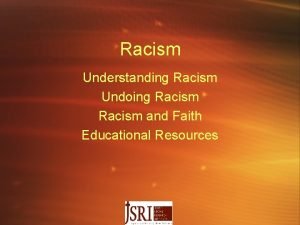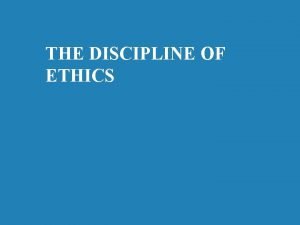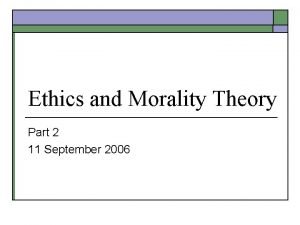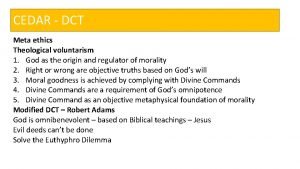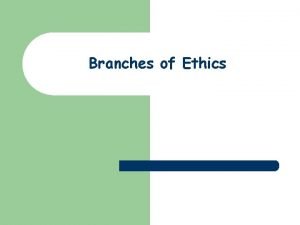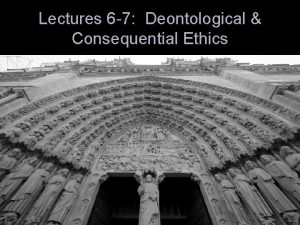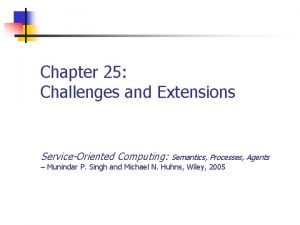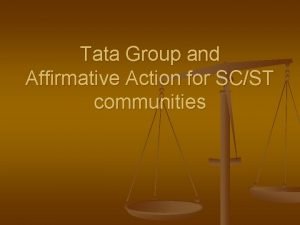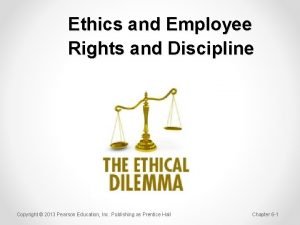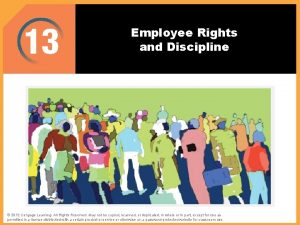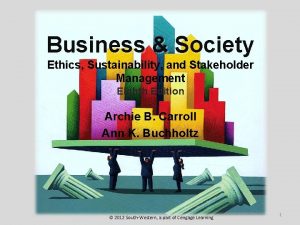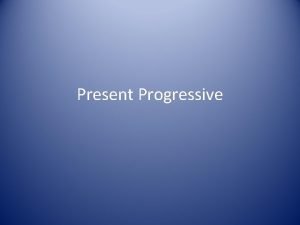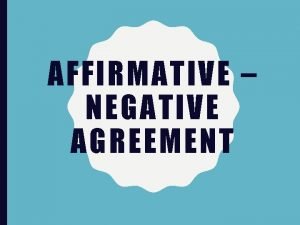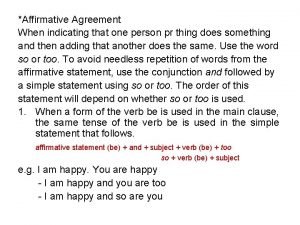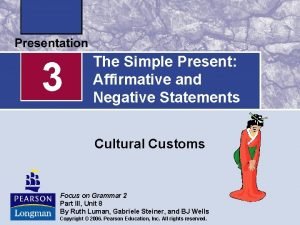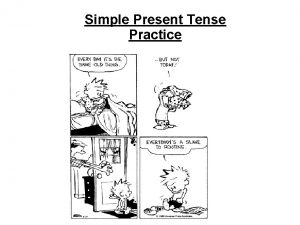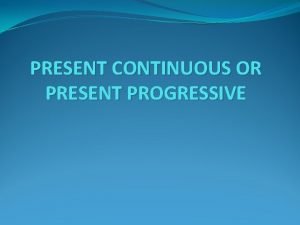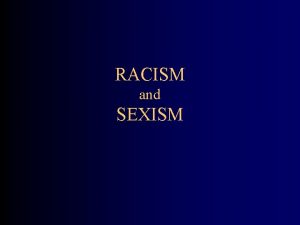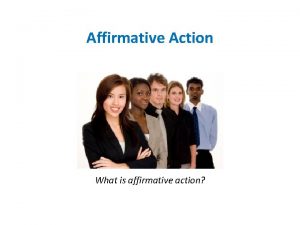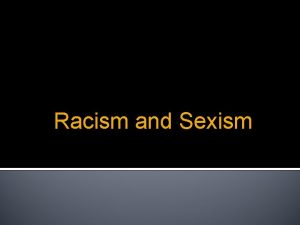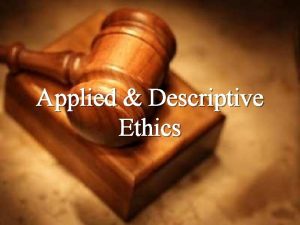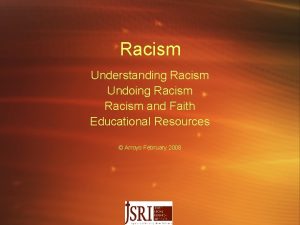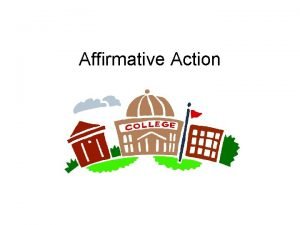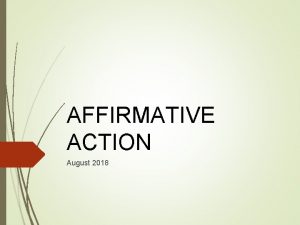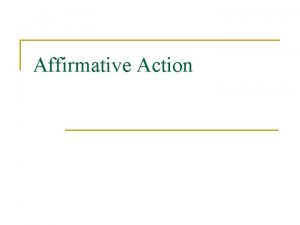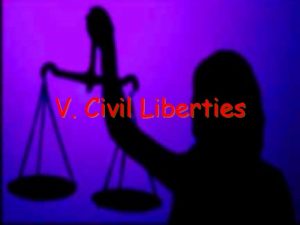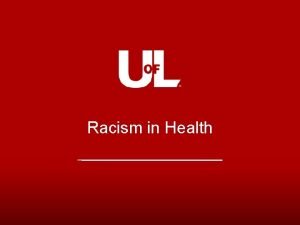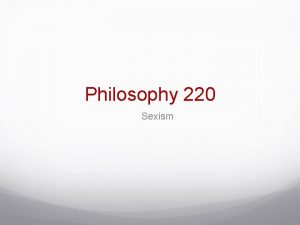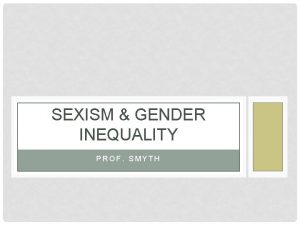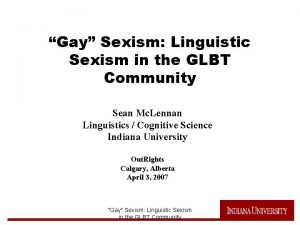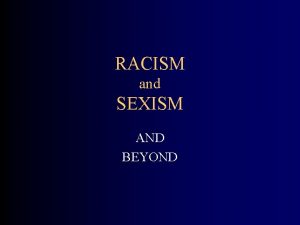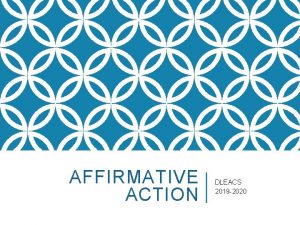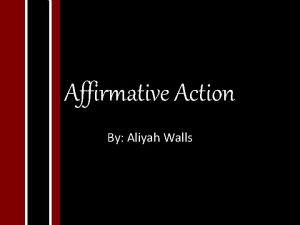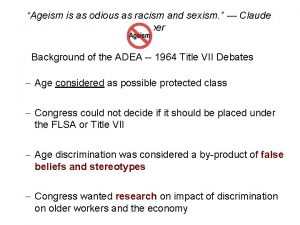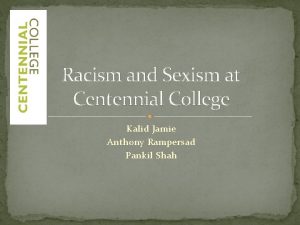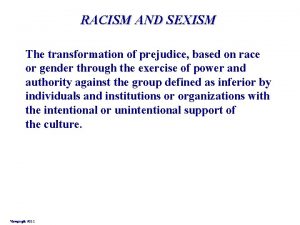Applied Ethics Sexism Racism and Affirmative Action 1







































































- Slides: 71

Applied Ethics Sexism, Racism, and Affirmative Action 1

Facts & Figures • Between 1996 and 2002, spousal abuse more than tripled, with most of the victims being women. • Violence against women within family, like wife-beating or wifekilling quite frequently happened in HK. 2

Gender Inequality in HK • Women tend to have poorer jobs and earn less. • Though we have the law on equal pay for equal work. 3

Gender Inequality in HK • Most people who earn $30, 000/month and upwards are men. • In 2000, the median monthly earning: --employed female was $8500 --employed male was $12, 000. 4

Gender Inequality in HK • Those workers earning less than $5, 000 a month (which defines the poor), • 75% are women working as cleaners, domestic helpers and restaurant workers, • with some earning as little as $3000 monthly. 5

Gender Inequality in HK • Male doctors > female doctors • Most nurses are female. • Nurse is subordinate to doctor 6

Gender Inequality in HK • While women comprise 52 % of Hong Kong’s population, • only 20% of elected officials are female. 7

Gender Inequality in HK • Until 1994, there were no laws prohibiting discrimination or sexual harassment in the private sector. • At present, three separate anti-discrimination laws, • which together prohibit discrimination on the grounds of sex, marital status, pregnancy, family status and disability. 8

Gender Inequality in USA • Women suffer from domestic violence at roughly four times the rate of men (2000) • In 2001, 73 women served in the US Congress (only 13. 6%) • No woman has ever been US President. 9

Gender Inequality • Of the top 100 wealthiest people in Forbes Magazine’s list for 2001, • only 10 were women. 10

Women gain the vote • • USA UK France Canada 1920 1930 1945 1949 • Before a woman was married, she was represented by her father; • After a woman was married, she was represented by her husband. 11

Racial discrimination • Discriminating against people based on skin colour. • In USA, the White people discriminated against the African-Americans, against the Asian-Americans. 12

Racial discrimination • Most Black people can only have low-paid and manual jobs. • 1985, 50% of black people chronically unemployed. 13

Racial discrimination • 1992, unemployment rate for African Americans was twice that for whites. • 1989, black median income was 54% that of whites. 14

Racial discrimination • White doctors > Black doctors • White lawyers > Black lawyers. 15

Racial discrimination • Barack Obama won the Presidential election in 2008 and became the first black President of USA. • Racism is now no more a social or moral issue in USA? 16

Racial discrimination • Apartheid Laws in South Africa before 1990 s. • White people (the minority) discriminated against the Black people (the majority). 17

Racial discrimination • HK is a plural and multi-races society, though the majority is Chinese. • Discriminating against the minorities, like, Pakistanis, Indians, Nepalese, still exists. 18

Racial discrimination • The minorities have poorer education, jobs (security guards, or night-watch men) and earn less. • We just passed an anti-racism law, in June/2008. 19

Fact or Value? • “All people, men or women, are equal. ” 20

Equality -- Prescriptive – Not descriptive – We should treat men and women equally. – Equality is a moral ideal. 21

All humans are equal? • A fact that humans are not equal, or are different. • Humans come in • • • -- different shapes and sizes, -- different moral capacities, -- different intellectual abilities, -- different feeling and sensitivity to the needs of others, -- different abilities to communicate effectively, -- different in other human capacities. 22

Principle of equality • Principle of equality is not a description, • but a prescription of how we ought to treat our fellow humans. 23

Principle of equality • Equals should be treated equally, unequals unequally. • Treat men and women equally, treat people of different races equally. 24

Principle of equality It is unjust to treat people differently in ways that deny to some of them significant social benefits unless we can show that there is a difference between them that is relevant to the differential treatment. 25

Equality of opportunity • In employment, it requires equal opportunity for all those with relevant skills and abilities to do the job in question. 26

Equality of opportunity • Anyone with relevant qualifications and skills should be given equal consideration when seeking employment. • No one should be discriminated against on racial or sexual grounds. 27

Principle of equality • In employment, qualification and experience are relevant difference to be considered. • Skin colour or sex is not a relevant consideration to employ a woman (or a black person) or not. 28

Principle of equality • In university admission, qualification and academic ability are relevant difference to be considered. • Skin colour or sex is not a relevant consideration to admit a girl (or a black person) or not. 29

Principle of justice • Treatment of persons be according to what is due to them on some grounds— justice as desert. • Justice as desert consists in one’s receiving what one merits or deserves, determined by what one has done. 30

Principle of justice • A hard-working woman deserves to be promoted but not a lazy man. • A well-qualified and lots-ofexperience black man should be employed but not a less-qualified and less-experienced white man. 31

Principle of justice • Justice consists of equal treatment or equal respect to all people • Actions or practices that treat people unequally are unjust. 32

Principle of justice • Justice does not favour one person over another on the basis of irrelevant characteristics, like, • sex, race, which we have no control. 33

Sexism (sexual discrimination) • Unjust discrimination based on sex. • Women are discriminated and disadvantaged by men, social beliefs, attitudes and practices. 34

Sexism Sex: – (1) natural or biological sense—women give birth to babies but men cannot. – (2) a social construct—gender-role differentiation; women look after children at home, men work and earn a living outside. – Gender-role differentiation is a socially created feature. 35

Racism • Unjust discrimination on the simple basis of skin colour. • Racism is wrong because racists make false judgments about or look down people of certain race. • Thus violating the moral principle of equality. 36

Racism • In physiological sense, race is a natural occurrence. • Diverse skin colours and related physiological features distributed among human beings, like appearance, blood group, and gene. • Classifying people upon the physiological variations or race is not in itself racism. 37

Racism • The concept of race could include the idea of ethnicity— • a set of cultures, traditions, religions, beliefs, attitudes, etc. , • which the community has created part of what it means to be of a race or ethnic group. 38

Racism • Ethnic (group) is a socially created feature of the world. • Chinese is a very large ethnic group. 39

Racism • How people think of themselves as belonging to a particular race could be an interesting issue. • A black individual undergoes medical surgeries and procedures that make him look white, does it make him white? 40

Racism • Is Michael Jackson black or white? 41

Racism • A white person fits in very well with the black and adopts the culture and custom of the black, • does it make her black? 42

What’s wrong with sexism/racism? 1) Not respect humanity—violated Kant’s Formula of an end in itself. • Morality demands fundamental respect for the dignity of persons, whether in the agent’s own person or in the person of the other. • Wrong to use the other merely as a means to an end she/he does not share. 43

What’s wrong with sexism/racism? 2)Sex/skin colour is not a relevant difference for different treatment. Thus, violating the principle of equality. 44

What’s wrong with sexism/racism? • Qualification and experience are relevant difference for different treatment in hiring a bank manager, • sex/race is irrelevant. 45

What’s wrong with sexism/racism? • Qualification and academic ability are relevant difference in admission to university, • sex/race is not. 46

What’s wrong with sexism/racism? 3) Violating the principle of justice—as desert or due. – A hardworking woman/black person deserves to be promoted, a lazy man/white does not. – Unequal treatments for women/black are unjust. 47

What’s wrong with sexism/racism? 4) Gender-role differentiated society could be restrictive to develop a person’s abilities and potentials. 48

What’s wrong with sexism/racism? • If a woman is confined in her house-work, she is restricted in developing her other natural or potential abilities and skills. • A woman could have developed her firefighting or boxing potential. • A man could have developed his caring or nurturing ability. 49

What’s wrong with sexism/racism? 5) The gender-role differentiated society is male-dominance (patriarchy). ---Women depend on men economically: women who look after children at home have no pay; but men work and earn a living outside. ---Women are penalized for their gender role, but men are rewarded. ---Man is the master of a family; ---Woman cannot be the Chief of a village; ---Woman cannot inherit family property; 50

What’s wrong with sexism/racism? • Gender-role differentiated societies have tended to concentrate power in the hands of males, • have developed institutions and inculcated ideologies that have perpetuated that power dominance and concentration. 51

What’s wrong with sexism/racism? 6) Sexual / racial differences are average differences, different treatment for particular individuals. 52

What’s wrong with sexism/racism? • On average, men are taller and stronger then women. • But some women are taller and stronger than men; • On average, women are more caring and nurturing than men. • But some men are more caring and nurturing than women. 53

What’s wrong with sexism/racism? • No evidence to show that the White is more intelligent than the Black. • Even on average, it is the case. • But some Black people are more intelligent that some White. 54

What’s wrong with sexism/racism? 7) Continuing sexist/racist practices and institutions entrench sexual/racist discrimination—the vicious circle. – The belief that women/black are inferior to white men, that sex-role could be ‘internalized’ as normal or as a norm, could perpetuate sexism/racism. 55

The vicious circle • • • • Social belief and practice that women look after children at home, men work and earn a living outside. ↓ Not many women work outside and earn a living of their own. ↓ Only some young women prepare themselves (in education and skill) to work outside. ↓ Only a few of these women succeed to gain a job in competition with men. ↓ Thus very few women work outside and earn a living. ↓ And if very few women work outside and earn a living of their own, then only some young women prepare themselves to work outside… ↓ The story continues in the same way… 56

Affirmative action • Affirmative action is a cluster of policies generated by the Civil Rights of 1964 or • a series of executive orders issued by President Lyndon Johnson, of USA. 57

Affirmative action • To remedy inequalities and injustices, • we need to do more than merely ‘Stop discriminating’. 58

Affirmative action • More immediate positive actions or measures are required • in order to restore equality and justice. 59

Affirmative action • Preference is given to women/Black people in some affirmative action; • but in some, no preferential treatment for women/Black people. 60

Some types of affirmative action (a) Enlarging the pool of applicants, then hiring or admitting on the basis of competence or qualification. --No preferential treatment 61

Some types of affirmative action (b) Giving preference to women/Black people among equally qualified applicants. (c) Giving preference to lessqualified female/Black applicants. 62

Some types of affirmative action (d) Setting goals or ideal numbers for which to aim; they need not involve preferences. (e) Setting quotas or fixed numbers to actually attain; these usually involve preferences. 63

Justifications for preferential affirmative action • Compensatory justice • A backward-looking reason; • to compensate for past wrongs and injustice done to women/Black people. 64

Justifications for preferential affirmative action • To break the vicious circle • give preferential treatment to women/Black people in order to set things right and equality between men and women (between different races) abruptly. 65

Justifications for preferential affirmative action • Utilitarian consideration • benefit from mutual respect and harmony between two sexes, different races; • benefit from the contributions of people who have different abilities, skills, interests and perspectives; • thus do more good than harm. 66

Justifications for preferential affirmative action • Past discrimination is a relevant difference for different treatment. • Equals be treated equally, unequals unequally. 67

Justifications for preferential affirmative action • Forward-looking consequentialist view—more social good than harm. • To eliminate the grave injustices of sexual/racial inequality, and thereby contributes to the achievement of a more egalitarian society, • the social good achieved will far outweigh the relatively minor injustices resulting from ‘reverse discrimination’. 68

Objections to preferential treatment • Reverse discrimination—unjust. • In the past, women/Black people were discriminated, now men/White people are discriminated. • But sex/race is not a relevant difference for different treatment. 69

Objections to preferential treatment • Compensate and punish the wrong persons. • The particular woman/Black person now we compensate is not a victim of discrimination; • The particular man/White person we now punish is not a wrong doer of past discrimination. 70

71
 Balcony speech romeo and juliet
Balcony speech romeo and juliet Lion king sexism
Lion king sexism What is sexist
What is sexist Sexism is interwoven with patriarchy
Sexism is interwoven with patriarchy Tom ford sexist
Tom ford sexist Shakespeares tragedy about racism and jealousy
Shakespeares tragedy about racism and jealousy Jealousy theme
Jealousy theme Racism and slavery
Racism and slavery Neil farrington
Neil farrington Compare micro-ethics and macro-ethics.
Compare micro-ethics and macro-ethics. To kill a mockingbird with page numbers
To kill a mockingbird with page numbers To kill a mockingbird racism chapter 1
To kill a mockingbird racism chapter 1 Othello act 1 analysis
Othello act 1 analysis Racism thematic statement
Racism thematic statement Cry
Cry Racism in huckleberry finn essay
Racism in huckleberry finn essay Whats a thematic statement
Whats a thematic statement What do about racism
What do about racism Racism scale
Racism scale Thematic statement examples for love
Thematic statement examples for love How does aunt alexandra treat calpurnia
How does aunt alexandra treat calpurnia Understanding racism
Understanding racism Heart of darkness part 3
Heart of darkness part 3 Rivets heart of darkness
Rivets heart of darkness Dreaming black boy james berry
Dreaming black boy james berry Descriptive ethics
Descriptive ethics Briefly recap
Briefly recap Aspects of honesty
Aspects of honesty Meta ethics vs normative ethics
Meta ethics vs normative ethics Descriptive ethics vs normative ethics
Descriptive ethics vs normative ethics Descriptive ethics vs normative ethics
Descriptive ethics vs normative ethics Meta ethics vs normative ethics
Meta ethics vs normative ethics 3 branches of ethics
3 branches of ethics Utilitarian vs deontological
Utilitarian vs deontological Teleological ethics vs deontological ethics
Teleological ethics vs deontological ethics Tata affirmative action program
Tata affirmative action program Affirmative action plan components
Affirmative action plan components What is the organized sequence of events called in a story?
What is the organized sequence of events called in a story? Part of the plot that introduces the characters/settings
Part of the plot that introduces the characters/settings 5 stages of plot diagram
5 stages of plot diagram Exposition rising action climax falling action resolution
Exposition rising action climax falling action resolution Suit the action to the word the word to the action meaning
Suit the action to the word the word to the action meaning Scope definition in research
Scope definition in research Contrast applied research and basic research
Contrast applied research and basic research Example of applied research
Example of applied research Basic and applied research
Basic and applied research Applied statistics and probability for engineers download
Applied statistics and probability for engineers download Vocational education & training in uae
Vocational education & training in uae Toxicology and applied pharmacology
Toxicology and applied pharmacology Columbia university power electronics
Columbia university power electronics Applied econometrics dimitrios asteriou
Applied econometrics dimitrios asteriou Rhythm stone
Rhythm stone History of applied linguistics
History of applied linguistics Uc ceas
Uc ceas International union of pure and applied physics
International union of pure and applied physics Association for applied and therapeutic humor
Association for applied and therapeutic humor Ethical discipline in the workplace
Ethical discipline in the workplace Ethics and employee rights and discipline
Ethics and employee rights and discipline Business and society ethics and stakeholder management
Business and society ethics and stakeholder management Uncle joe wear glasses
Uncle joe wear glasses Negative prefixes safe
Negative prefixes safe Affirmative agreement
Affirmative agreement Affirmative and negative spanish words
Affirmative and negative spanish words V words to describe someone negatively
V words to describe someone negatively El no trae grapadora
El no trae grapadora Affirmative and negative agreement
Affirmative and negative agreement Affirmative present simple sentences
Affirmative present simple sentences Present simple affirmative and negative
Present simple affirmative and negative Present contnuous
Present contnuous Present continuous of tie
Present continuous of tie Did not past simple
Did not past simple Assertive sentence and affirmative sentence
Assertive sentence and affirmative sentence


